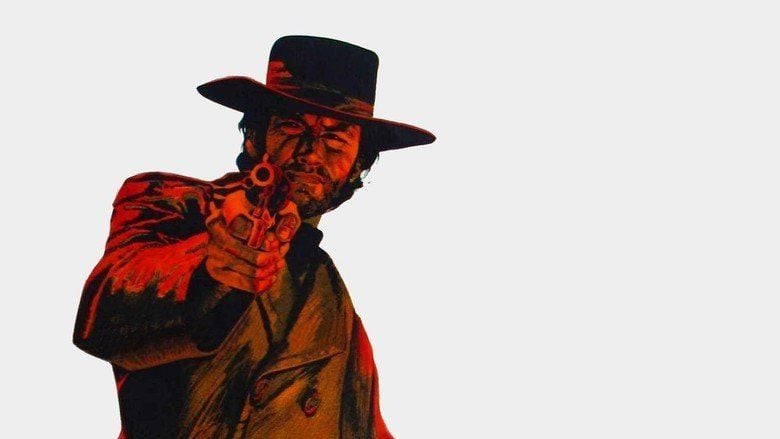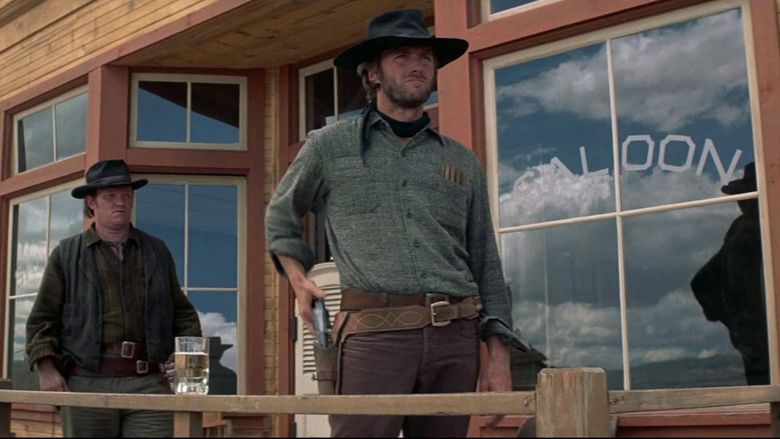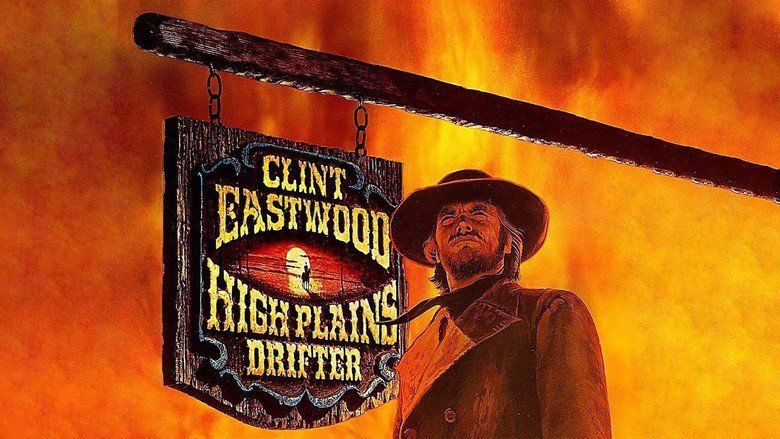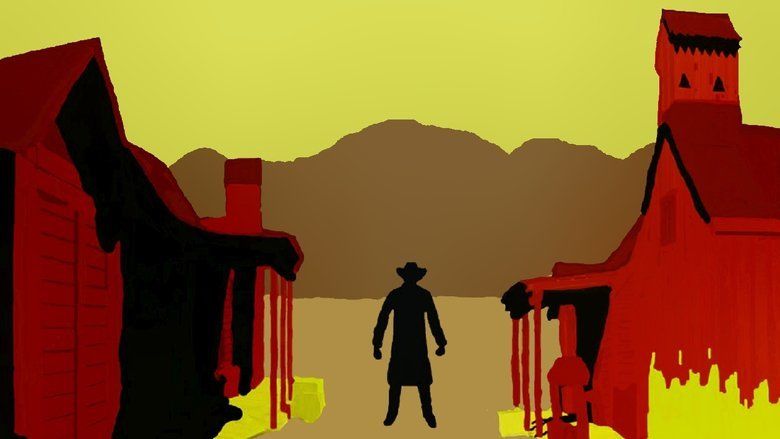High Plains Drifter
8.6 /10 1 Votes
96% Rotten Tomatoes Duration Country United States | 7.6/10 IMDb Initial DVD release February 24, 1998 Language English | |||||||||||||||||||||||||||||||||
 | ||||||||||||||||||||||||||||||||||
Release date August 22, 1973 (1973-08-22) Cast (The Stranger), (Sarah Belding), Marianna Hill (Callie Travers), (Dave Drake), (Morgan Allen), (Mayor Jason Hobart)Similar movies A Minute To Pray, A Second To Die , Cowboys & Aliens , Young Guns , Wyatt Earp , American Outlaws , The Great Silence Tagline Welcome to Hell | ||||||||||||||||||||||||||||||||||
High plains drifter official trailer 1 clint eastwood movie 1973 hd
High Plains Drifter is a 1973 American Western film directed by and starring Clint Eastwood, written by Ernest Tidyman, and produced by Robert Daley for Malpaso Company and Universal Pictures. Eastwood plays a mysterious, prepotent stranger, meting out justice in a corrupt frontier mining town. The film was influenced by the work of Eastwood's two major collaborators, film directors Sergio Leone and Don Siegel.
Contents
- High plains drifter official trailer 1 clint eastwood movie 1973 hd
- High plains drifter 5 8 movie clip he shot my ear off 1973 hd
- Plot
- Production
- Reception
- High plains drifter 6 8 movie clip a whipping revenge 1973 hd
- References

The film was shot on location on the shores of Mono Lake, California. Dee Barton wrote the film score. The film was critically acclaimed at the time of its initial release and remains popular today, holding a score of 96% at the review aggregate website Rotten Tomatoes.

High plains drifter 5 8 movie clip he shot my ear off 1973 hd
Plot

A mysterious stranger with no name (Eastwood) rides out of the desert, into the isolated mining town of Lago, on the shore of a small lake in an unnamed western territory. Three men follow him into the saloon, taunting him, then follow him to the barbershop. When they challenge him, he kills all three with little effort. Attractive townswoman Callie Travers (Mariana Hill) deliberately bumps into him in the street, knocks his cigar from his mouth, and loudly insults him. He drags her into the livery stable and rapes her.

That night, in his hotel room, the Stranger dreams of a man being brutally whipped. Then, in a flashback, Jim Duncan (Buddy Van Horn), a federal marshal bearing an uncanny resemblance to the Stranger, is whipped to death in front of the hotel by outlaws Stacey Bridges (Geoffrey Lewis) and brothers Dan and Cole Carlin (Dan Vadis and Anthony James) as the people of Lago look on.

Sheriff Sam Shaw (Walter Barnes) approaches the Stranger and offers him the job previously held by the men he killed—defending the town from Bridges and the Carlins, who are about to be released from jail. He declines. Shaw, in desperation, offers him anything he wants in return. Eventually, the Stranger learns why they are so desperate: Not only did the townspeople do nothing to prevent Duncan's murder, but some were complicit in it; they hired the outlaws to kill him after he discovered that the town's only source of income, the mine, was on government land, and therefore illegal. They then double-crossed the murderers and turned them in.

Upon learning this, the Stranger accepts the job, and takes full advantage of the deal. He appoints diminutive barbershop employee Mordecai (Billy Curtis) sheriff and mayor, and after the shopkeeper (Richard Bull) insults a Native American and his children and tries to eject them from his store, he provides them with a large cache of supplies at the shopkeeper's expense. He orders the hotel owner, Lewis Belding (Ted Hartley), to vacate the premises along with all the other guests, leaving him its sole occupant. He then orders Belding's barn dismantled, and the lumber used to build picnic tables. When Belding’s wife Sarah (Verna Bloom) objects, he drags her, kicking and screaming, into her bedroom. The next morning, a post-coital Sarah tells the Stranger that Duncan cannot rest in peace, because he is buried in an unmarked grave outside of town.

The Stranger instructs the townspeople in defensive tactics, but they clearly lack the skills or courage for the job. He also orders that every building in town be painted blood red. “Surely you don’t mean the church too!” exclaims the preacher (Robert Donner). “I mean especially the church,” he replies. Then, without explanation, he mounts his horse and rides out of town, pausing to replace “Lago” on the town sign with “Hell”.
Meanwhile, Bridges and his gang have been wreaking havoc on their way to Lago. The Stranger harasses them with dynamite and long-range rifle fire, leaving them to ponder the identity of their mysterious attacker. Returning to Lago, the Stranger inspects the preparations—town painted red, townsmen with rifles stationed on rooftops, picnic tables laden with food and drink, and a big "WELCOME" banner overhead—then, to everyone’s consternation, he remounts and departs again.
The Bridges gang arrives and easily overcomes the inept resistance of the townspeople. Bridges shoots several of the corrupt civic leaders who double-crossed them. By nightfall the town is in flames, and the terrified townspeople are huddled in the saloon. A mysterious sound is heard in the street; when Cole Carlin walks outside to investigate, the criminals and townspeople listen in horror as he is whipped to death. Dan Carlin is found dead too, hanging from another whip. At last the Stranger reveals himself, beats Bridges to the draw, and kills him. Belding sneaks behind the Stranger, intending to shoot him in the back, but Mordecai shoots him dead.
On his way out of town the following morning, the Stranger pauses at the cemetery as Mordecai is finishing a new grave marker. “I never did know your name,” Mordecai says. "Yes, you do," the Stranger replies. As he rides past a bewildered Mordecai into the desert whence he came, the writing on the new headstone is revealed: Marshal Jim Duncan — Rest in Peace.
Production
Eastwood reportedly liked the offbeat quality of the film's original nine-page proposal, and approached Universal with the idea of directing it. Under a joint production between Malpaso and Universal, the original screenplay was written by Ernest Tidyman, who had won a Best Screenplay Oscar for The French Connection. Tidyman's screenplay was inspired by the real-life murder of Kitty Genovese in Queens in 1964, which eyewitnesses reportedly stood by and watched. Holes in the plot were filled in with black humor and allegory, influenced by Sergio Leone. An uncredited rewrite of the script was provided by Dean Riesner, screenwriter of other Eastwood projects.
Universal wanted Eastwood to shoot the feature on its back lot, but Eastwood opted instead to film on location. After scouting locations alone in a pickup truck in Oregon, Nevada and California, he settled on the "highly photogenic" Mono Lake area. Over 50 technicians and construction workers built an entire town—14 houses, a church, and a two-story hotel—in 18 days, using 150,000 feet of timber. Complete buildings, rather than facades, were built, so that Eastwood could shoot interior scenes on the site. Additional scenes were filmed at Reno, Nevada's Winnemucca Lake and California's Inyo National Forest. The film was completed in six weeks, two days ahead of schedule, and under budget.
The character of Marshal Duncan was played by Buddy Van Horn, Eastwood's long-time stunt double, to suggest that he and the Stranger could be the same person. In an interview, Eastwood said that earlier versions of the script made the Stranger the dead marshal's brother. He favored a less explicit and more supernatural interpretation, and excised the reference. The Italian, Spanish, French and German dubbings restored it. "It's just an allegory," he said, "a speculation on what happens when they go ahead and kill the sheriff and somebody comes back and calls the town's conscience to bear. There's always retribution for your deeds." The graveyard set featured in the film's final scene included tombstones inscribed "Sergio Leone" and "Don Siegel" as a humorous tribute to the two influential directors.
Reception
Universal released the R-rated High Plains Drifter in the US in April 1973, and the film eventually grossed $15.7 million domestically, ultimately making it the sixth-highest grossing Western in North America in the decade of the 1970s and the 20th highest-grossing film released in 1973. The film was well received by many critics, and rates 96% positive on Rotten Tomatoes.
The film had its share of detractors. A number of critics thought Eastwood's directing derivative; Arthur Knight in Saturday Review remarked that Eastwood had "absorbed the approaches of Siegel and Leone and fused them with his own paranoid vision of society". Jon Landau of Rolling Stone concurred, noting "thematic shallowness" and "verbal archness"; but he expressed approval of the dramatic scenery and cinematography. John Wayne criticized the film's iconoclastic approach; in a letter to Eastwood, he wrote, "That isn't what the West was all about. That isn't the American people who settled this country." The New York Times described the movie as "part ghost story, part revenge Western, more than a little silly, and often quite entertaining in a way that may make you wonder if you have lost your good sense".
The film was recognized by American Film Institute in 2008 on AFI's 10 Top 10 in the category "Nominated Western Film."
High plains drifter 6 8 movie clip a whipping revenge 1973 hd
References
High Plains Drifter WikipediaHigh Plains Drifter IMDbHigh Plains Drifter Rotten TomatoesHigh Plains Drifter themoviedb.org
